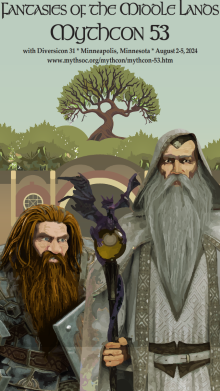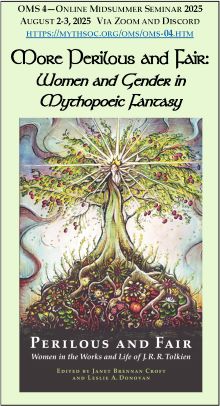Loading...
Location
Minneapolis, Minnesota
Document Type
Presentation
Event Website
https://www.mythsoc.org/mythcon/mythcon-53.htm
Start Date
2-8-2024 4:30 PM
End Date
2-8-2024 5:20 PM
Description
Several scholars, including Tom Shippey, Philip Mitchell, and Gordon Sleuthag, all agree that Tom Bombadil is, among other things, Tolkien’s representation of the genius loci of the Old Forest. The argument is plausible and coherent, but there is much more that can be said about the spirits of places in Tolkien’s legendarium, and the traditions he draws from to craft his world of storied and mutable place. In general, an affection and attention for the local, which Tolkien extols in his letters and fiction, is rather amenable to ideas concerning the genius loci, as theorists such as Yi-Fu Tuan and Edward Casey argue. The idea of the genius loci was present in and important to some of the medieval texts that Tolkien studied and taught, and the concept of the genius loci was noted (and discussed) by other Inklings, including C.S. Lewis and Charles Williams. This paper aims to demonstrate that there are quite a few episodes in The Hobbit and The Lord of the Rings where there is a fittingness between names, places, vital effluence, and the sorts of creatures and spirits that “inhabit” places. The idea of the genius loci also has bearing for how Tolkien imagines the moral dimensions of improving and building, versus despoliation and imposition. My own proposal is that Bombadil is much more like the concept of the god Genius, rather than a single genius loci. Creatures such as the ents, the spiders, giants, the warders of Cirith Ungol, the Wose, and the Watcher in the Waters all evince genii loci.
Creative Commons License

This work is licensed under a Creative Commons Attribution-NonCommercial-No Derivative Works 4.0 International License.
Included in
The Genii Loci in the Midst of Middle Earth
Minneapolis, Minnesota
Several scholars, including Tom Shippey, Philip Mitchell, and Gordon Sleuthag, all agree that Tom Bombadil is, among other things, Tolkien’s representation of the genius loci of the Old Forest. The argument is plausible and coherent, but there is much more that can be said about the spirits of places in Tolkien’s legendarium, and the traditions he draws from to craft his world of storied and mutable place. In general, an affection and attention for the local, which Tolkien extols in his letters and fiction, is rather amenable to ideas concerning the genius loci, as theorists such as Yi-Fu Tuan and Edward Casey argue. The idea of the genius loci was present in and important to some of the medieval texts that Tolkien studied and taught, and the concept of the genius loci was noted (and discussed) by other Inklings, including C.S. Lewis and Charles Williams. This paper aims to demonstrate that there are quite a few episodes in The Hobbit and The Lord of the Rings where there is a fittingness between names, places, vital effluence, and the sorts of creatures and spirits that “inhabit” places. The idea of the genius loci also has bearing for how Tolkien imagines the moral dimensions of improving and building, versus despoliation and imposition. My own proposal is that Bombadil is much more like the concept of the god Genius, rather than a single genius loci. Creatures such as the ents, the spiders, giants, the warders of Cirith Ungol, the Wose, and the Watcher in the Waters all evince genii loci.
https://dc.swosu.edu/mythcon/mc53/schedule/14


